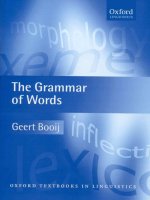the ideals of instrumental music
Bạn đang xem bản rút gọn của tài liệu. Xem và tải ngay bản đầy đủ của tài liệu tại đây (28.44 KB, 3 trang )
The Ideals of Instrumental Music
At one point in the study of the Romantic period of music,
we come upon
the first of several apparently opposing conditions that plague
all attempts to
grasp the meaning of Romantic as applied to the music of the 19th
century. This
opposition involved the relation between music and words. If
instrumental
music is the perfect Romantic art, why is it acknowledged that
the great masters
of the symphony, the highest form of instrumental music, were not
Romantic
composers, but were the Classical composers, Haydn, Mozart, and
Beethoven?
Moreover, one of the most characteristic 19th century genres was
the Lied, a
vocal piece in which Shubert, Schumann, Brahams, and Wolf
attained a new union
between music and poetry. Furthermore, a large number of leading
composers in
the 19th century were extremely interested and articulate in
literary
expression, and leading Romantic novelists and poets wrote about
music with
deep love and insight.
The conflict between the ideal of pure instrumental music
(absolute
music) as the ultimate Romantic mode of expression, and the
strong literary
orientation of the 19th century, was resolved in the conception
of program
music. Program music, as Liszt and others in the 19th century
used the term,
is music associated with poetic, descriptive, and even narrative
subject
matter. This is done not by means of musical figures imitating
natural sounds
and movements, but by imaginative suggestion. Program music
aimed to absorb
and transmit the imagined subject matter in such a way that the
resulting work,
although "programmed", does not sound forced, and transcends the
subject matter
it seeks to represent. Instrumental music thus became a vehicle
for the
utterance of thoughts which, although first hinted in words, may
ultimately be
beyond the power of words to fully express.
Practically every composer of the era was, to some degree,
writing
program music, weather or not this was publicly acknowledged.
One reason it
was soeasy for listeners to connect a scene or a story or a poem
with a piece
of Romantic music is that often the composer himself, perhaps
unconsciously,
was working from some such ideas. Writers on music projected
their own
conceptions of the expressive functions of music into the past,
and read
Romantic programs into the instrumental works not only of
Beethoven, but also
the likes of Mozart, Haydn, and Bach!
The diffused scenic effects in the music of such composers
as Mendelssohn
and Schumann seem pale when compared to the feverish, and
detailed drama that
constitutes the story of Berlioz's Symphonie fantastique (1830).
Because his
imagination always seemed to run in parallel literary and musical
channels,
Berlioz once subtitled his work "Episode in the life of an
artist", and
provided a program for it which was in effect a piece of Romantic
autobiography.
In later years, he conceded that if necessary, when the symphony
was performed
by itself in concert, the program would need not be given out for
the music
would "of itself, and irrespective of any dramatic aim, offer an
interest in
the musical sense alone." The principle formal departure in the
symphony is
the recurrence of the opening theme of the first Allegro, the
idee fixe. This,
according to the program, is the obsessive image of the hero's
beloved, that
recurs in the other movements. To mention another example: in
the coda of the
Adagio there is a passage for solo English horn and four Tympani
intended to
suggest "distant thunder".
The foremost composer of program music after Beriloz was
Franz Liszt,
twelve of whose symphonic poems were written between 1848 and
1858. The name
symphonic poem is significant: these pieces are symphonic, but
Liszt did not
call them symphonies, presumably because or their short length,
and the fact
that they are not divided up into movements. Instead, each is a
continuos form
with various sections, more or less varied in tempo and
character, and a few
themes that are varied, developed, or repeated within the design
of the work.
Les Preludes, the only one that is still played much today, is
well designed,
melodious, and efficiently scored. However, its idiom causes it
to be
rhetorical in a sense. It forces today's listeners to here
lavishly excessive
emotion on ideas that do not seem sufficiently important for such
a display of
feeling.
Liszt's two symphonies were as programmatic as his
symphonic poems. His
masterpiece, the Faust Symphony, was dedicated to Berlioz. It
consists of
three movements entitled respectively Faust, Gretchen, and
Mephistopheles, with
a finale (added later) which is a setting for tenor soloist and
male chorus.
The first three movements correspond to the classic plan of an
introduction in
Allegro, Andante, and Scherzo. Liszt attempted to sum up the
ideas of Romantic
music in these words:
"Music embodies feeling without forcing it - as it is
forced in its
other manifestations, in most arts and especially in the art of
words - to
contend and combine with thought it is the embodied and
intelligent essence
of feeling; capable of being apprehended by our senses, it
permeates them like
a dart, like a ray, like a dew, like a spirit, and fills our
soul."









